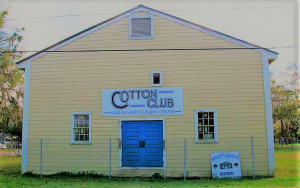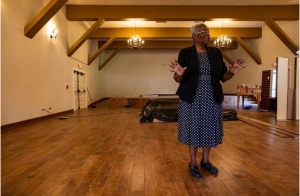The Cotton Club Museum and Cultural Center (CCMCC):
The Cotton Club Museum is a community collaboration passionately dedicated to preserving, promoting, and protecting the African American history and culture of North Central Florida through education and the arts- with an emphasis on music!
Visit the museum at: 837 SE 7th Avenue, Gainesville, Florida.


The High Notes practiced two to three times a week in one of the band member’s home. This photo was taken in 1957 while performing at a local fraternity house. (Band members from left to right) Vocalist James Henry, 27, Marion McClellan, 30, Richard McClellan, 27, Hampton McClellan, 24.
Project Overview
The Cotton Club site consists of the Cotton Club/Blue Note (often referred to as the Hall), the Perryman Grocery Store, and four shot-gun houses. All of the buildings are on the 1950 Sanborn Map in their current locations. The CCMCC project aims to restore for adaptive use all six buildings, creating a heritage tourism destination that will provide a glimpse of African American life during the period of racial segregation in the United States.
Preserving the Cotton Club building, along with the Perryman Store and the four shotgun houses that share the 1.6 acre site, will ensure that future generations never forget the historic richness and legacy of a time and place that impacted and enriched the lives of an entire nation of people.
Plans for the site, which have been developed in collaboration with Santa Fe College and the University of Florida’s Powell Center for Construction and Environment in the Rinker School of Building Construction, will utilize all of the structures on the site. The Cotton Club building will house a museum and serve as a large-scale performance space. The Perryman store is designated to become a café and mini museum with a farmer’s market for local growers. In addition to the existing structures, an additional building has been constructed to house the necessary support facilities such as restrooms.

The High Notes’ business card used in the mid ’50s. The band performed at the
Cotton Club of Gainesville and traveled to surrounding counties to perform popular rhythm and blues music
History of the Cotton Club Building
The wood frame structure that became the Cotton Club in Gainesville, Florida was built by U. S. soldiers between 1940 -1941 as a Post Exchange (PX) at Camp Blanding in Starke, Florida north of Gainesville. In March of 1946, at the end of World War II, the building was placed on sale, along with several others. William and Eunice Perryman, who owned a grocery store on what was then called the East Depot Avenue or Cecil Avenue (now SE 7th Ave) in Gainesville’s Springhill community made a successful bid for one of the PX buildings. They moved it, in several pieces, down the Waldo Road to a lot near their store.
The building was opened for the first time in its new location as the Perry Theater. At that time a cement projection room was installed in the north end of the building, which was a requirement for buildings that housed flammable film for theatre use. According to Gainesville City Directories, the Perry Theater was in operation during 1948 and 1949. In keeping with the segregation laws of the period, the Perry Theater was opened to serve the African Americans only. The theater only survived a short time because during that era African Americans in Gainesville also patronized the all Black Lincoln and Rose theaters on what was then known as Seminary Lane (NW 5th Avenue).
Shortly after the close of the Perry Theater, the building became the site for what was then called a “big bands’ club” operated by Sarah McKnight. Charles and Sarah McKnight named the club after the famous Cotton Club in Harlem, which was experiencing its most successful years. The Gainesville Cotton Club is listed in the 1951-1952 city directory as a place where beverages were sold. As the club gained popularity, it hosted performances by African American performers as they worked the Chit’lin Circuit, many of whom are now hailed nationally and internationally for their musical contributions to the world. The McKnights, who ran the Cotton Club, revealed that African American entertainers who appeared at the Cotton Club and went on to attain national fame included James Brown, B.B. King, Ray Charles, Brook Benton, and Bo Diddley. Unfortunately, the City of Gainesville refused to renew the club’s liquor license and the “lively run” of the Cotton Club came to an end.
The Cotton Club building continued to serve as an entertainment venue between 1953 and 1959. During that time, it was described as a ballroom and was named the Blue Note Club. With a jukebox for entertainment and beer as its primary alcoholic beverage, the Blue Note Club never attained the popularity of the Cotton Club but it provided many evenings of entertainment.

When the Blue Note Club closed in the late 1950s, the building was purchased by Kenneth Gibbs and used as a warehouse for the Babcock Furniture Company until 1970, after which it remained vacant. In 1995, the Cotton Club building, along with the other five structures on the 1.6 acre site, was sold to Mt. Olive African Methodist Episcopal, which sits on the Southwest corner of the Cotton Club site at 730 Southeast 8th Street.
The original Cotton Club site held nine structures. The six that remain standing at this time include the large building, known as the Cotton Club, a small wooden grocery store with signage on the building that names it as the Perryman Grocery Store, and four “shotgun” houses. Two of the shotgun houses face SE 8th Street, adjacent to the church, while the store is on the corner of SE 8th Street and SE 7th Avenue. The remaining two shotgun houses are on SE 9th Street behind the Cotton Club building.
The structures on the Cotton Club site are significant in their portrayal of life during the period of segregation of the races in America’s history. They give presence to an era in African American history which is disappearing without being recorded. It was a time during which most newspapers carried very little, if any, news about Black people. The local Gainesville newspaper was no exception. A small section of the newspaper was given to an African American columnist, Mr. Childs, who reported obituaries, usually of the more prominent Blacks. When space allowed, Mr. Childs reported news items of events in the community. Vivian Filer remembers being in the paper in 1955 because she won a $0.25 pack of notebook paper for her skills on the dance floor. Her dancing partner was the son of the family that owned the Dunbar Hotel, the only Black hotel in Gainesville. Many of the accomplishments of African Americans were left untold, especially that of the largest segment of the African American community, the struggling, hardworking segment.
The Cotton Club, site with its historic significance, illustrates the close proximity in which people worked, shopped, played, and worshipped. The buildings, with their weathered siding and hurricane damaged roofs, are easily overlooked, however, doing so would be a tragic mistake.
